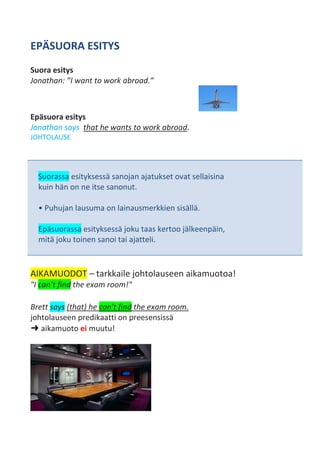EpÃĊsuora esitys englannin kielessÃĊ
- 1. Ritva Tammi 2011 EPÃSUORA ESITYS Suora esitys Jonathan: âI want to work abroad.â EpÃĊsuora esitys Jonathan says that he wants to work abroad. JOHTOLAUSE Suorassa esityksessÃĊ sanojan ajatukset ovat sellaisina kuin hÃĊn on ne itse sanonut. âḃ Puhujan lausuma on lainausmerkkien sisÃĊllÃĊ. EpÃĊsuorassa esityksessÃĊ joku taas kertoo jÃĊlkeenpÃĊin, mitÃĊ joku toinen sanoi tai ajatteli. AIKAMUODOT â tarkkaile johtolauseen aikamuotoa! "I canât find the exam room!" Brett says (that) he can't find the exam room. johtolauseen predikaatti on preesensissÃĊ â aikamuoto ei muutu!
- 2. "I canât find the exam room!" Brett said (that) he couldn't find the exam room. johtolauseen predikaatti on imperfektissÃĊ â Aikamuodot muuttuvat seuraavalla tavalla: SUORA ESITYS -> EPÃSUORA ESITYS preesens â imperfekti imperfekti â pluskvamperfekti perfekti â pluskvamperfekti pluskvamperfekti â pluskvamperfekti pysyy samana! futuuri â konditionaali konditionaali â konditionaali pysyy samana! EsimerkkejÃĊ "I applied for a job at EuroDisney." ïẀ Ann said that she had applied for a job at EuroDisney. "My French has improved a lot." ïẀ Ann said that her French had improved a lot. "We will win the match." ïẀ The players said that they would win the match.
- 3. PRONOMINIT Suoran esityksen pronominit muuttuvat kerronnan mukaan. Jonathan said, "I don't want to sit this exam!" ïẀ Mark said that he didn't want to sit that exam. My teacher said, "You got straight As in all your exams." ïẀ My teacher told me that I had got straight As in all my exams. AJAN JA PAIKAN MÃÃREET Suoran esityksen ajan ja paikan mÃĊÃĊreet muuttuvat tilanteen mukaan. Jonathan: "I canât give you my answer now." ïẀ Jonathan explained that he couldnât give us his answer then. Craig: "I have a job interview next Friday." ïẀ Craig told us that he had a job interview the following Friday. EPÃSUORAT KYSYMYSLAUSEET P S âWhat are you going to do tonight?â ïẀ Sharon wants to know what I am going to do tonight. JOHTOLAUSE S P âWhy donât you study psychology?â ïẀ Mum keeps asking me why I donât study medicine. EpÃĊsuoran kysymyslauseen sanajÃĊrjestys on suora eli subjekti on ennen predikaattia. âAre you ready?â the teacher asked.
- 4. ïẀ The teacher asked if/whether we were ready. âḃ Jos kysymyssanaa ei ole, epÃĊsuora kysymys aloitetaan sanalla if tai whether (= -ko, -kö). âḃ EpÃĊsuoriin kysymyksiin pÃĊtevÃĊt samat aikamuotosÃĊÃĊnnöt ja pronominien ja ajan mÃĊÃĊreiden muutokset kuin toteamuslauseisiin. âḃ EpÃĊsuorassa esityksessÃĊ sivulauseen eteen ei tule pilkkua eikÃĊ lauseen lopussa ole kysymysmerkkiÃĊ (ellei johtolause ole kysymys). EPÃSUORAT KÃSKYT JA PYYNNÃT âStand up straight!â the general ordered. ïẀ The general ordered us to stand up straight. âDon't look!â my friend warned me. ïẀ My friend warned me not to look. esim.verbit ask, tell, advise, command + objekti (kuka tekee) + infinitiivi (to look / not to look) Ritva Tammi 2011





